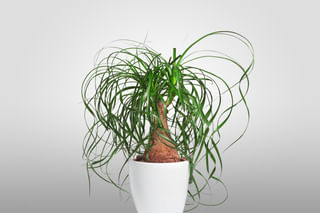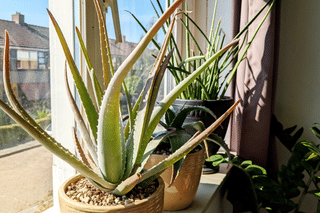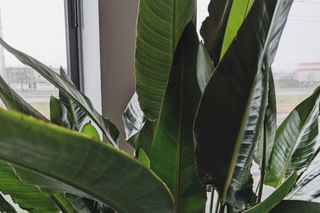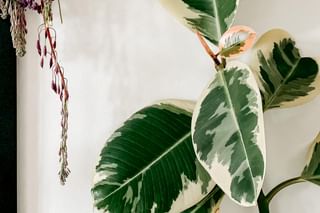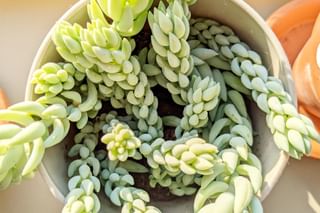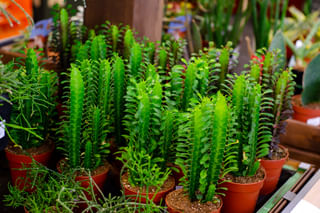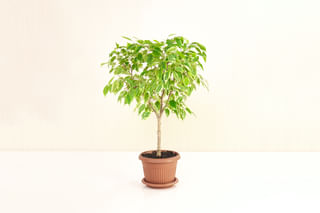The 10 easiest sun-loving houseplants
Find out which houseplants are easy to care for and love the sun. Learn how to pick a spot in your home, water them properly, give them good light and other great tips.
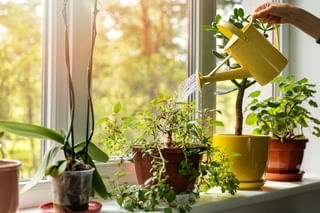
Not all plants like a lot of sunlight, some prefer the darker corners of your house. Some plants love sunny spots but are quite difficult to take care of. These plants are also not an option for you! In this plant care guide, we're going to look at 10 of the easiest houseplants that will thrive in bright light. With a little care, you'll have these plants looking great for a long time.
These are the 10 easiest houseplants that love bright spots:
So grab your gardening gloves and get ready to add some green to your home!
Snake plant (Sansevieria)

The sansevieria, also known as the snake plant, is an easy-to-care-for plant because it is very resilient and can tolerate a wide range of growing conditions. It is drought-resistant and does not need to be watered very often, making it a low-maintenance option for busy plant owners.
When it comes to the type of light this plant likes, it's quite surprising: the snake plant can thrive both in low-light environments and also in direct light. It's a very versatile houseplant. The best part of the sansevieria is that it's very tough and doesn't suffer from many pests, which makes it a perfect plant for beginning plant owners.
For more information about the snake plant, make sure you read my comprehensive guide on how to take care of a snake plant.
Ponytail Palm (Beaucarnea recurvata)
The ponytail palm is a great option for those looking for an easy-to-care-for plant that loves the sun. It's a slow-growing succulent with long, thin leaves that look like a fountain of water coming out of the trunk of this miniature tree.
The ponytail palm thrives in bright light and loves to grow in dry soil, so it's very important to avoid overwatering it. It's very sensitive to overwatering, so it's best to let the soil dry out completely before you water it again.
When it comes to pests, you might find spider mites or scale on your houseplant. You can recognize the spider mites by white cotton balls on the leaves or spider webs. You can recognize scale by black or brown bumps on the leaves.
If you're interested in learning more about the ponytail palm, be sure to check out my comprehensive guide on how to take care of a ponytail palm.
Jade plant (Crassula ovata)

The Crassula ovata, also known as the jade plant, is a tree-like succulent that needs minimal care to thrive. It is a drought-resistant plant, so it only needs to be watered when the soil is completely dry. The jade plant likes a sunny spot with plenty of indirect light in your house, but it can also grow in low-light environments.
It is important to keep the plant in well-draining soil and avoid overwatering, as this can lead to root rot. The jade plant is also sensitive to temperature changes, so it should be put in a spot where the temperature doesn't change from warm to cold very often. With proper care, the jade plant can grow into a large, lush, and attractive vibrant addition to any home or office.
If you're interested in learning more about the jade plant, be sure to check out my guide on how to take care of a jade plant.
Aloe vera
The aloe vera plant is one of the most beloved houseplants out there due to its healing properties as well as its unique appearance. Aloe plants truly love the sun, so it's the perfect plant for that empty sunny spot in your house. It's a very low-maintenance plant that likes to be left alone for weeks at a time.
Aloe vera plants can also be prone to root rot if you've accidentally overwatered them, so make sure the soil dries out completely before you water it again. The Aloe vera stores a lot of moisture in its leaves, so it can take several weeks before you'll need to water it. Once you start to see wrinkles in your Aloe vera leaves, it's time to water them again.
If you're interested in learning more about the aloe vera plant, be sure to check out my comprehensive guide on how to take care of an aloe vera.
Christmas cactus (Schlumbergera)

The Christmas cactus is a great choice for those looking for an easy-care plant that loves the sun. This low-maintenance succulent does best in bright light and doesn't need to be watered very often, making it perfect for busy plant owners who forget to water their plants sometimes. The Christmas cactus is also known for its colorful flowers which appear around the holiday season - what better way to celebrate than with beautiful flowers.
Like the succulents we've already looked at, the Christmas Cactus thrives in a dry environment. It's also quite sensitive to overwatering, so it's best to wait for the soil to dry out completely before you water your cactus again.
If you're interested in learning more about the Christmas cactus, be sure to check out my guide on how to take care of a Christmas cactus.
Bird of Paradise (Strelitzia reginae)
The bird of paradise is a stunning plant that is sure to brighten up any room. It loves the sun and does best in bright, indirect light - just make sure you don't put it in direct sunlight during the afternoon for more than a few hours, as this could cause sunburns on its leaves. This low-maintenance plant doesn't need too much water, but it's important to keep an eye out for signs that your strelitzia needs water, such as drooping leaves.
The bird of paradise plant deals with several common pests. These include mealybugs, aphids, and scale insects. Mealybugs can be identified by their white, cottony appearance and can be found on the underside of leaves or the plant's stems. Aphids are small, green, or black insects that can be found on new growth and can cause stunted growth and distortion of leaves. Scale insects are small, oval-shaped insects that attach themselves to the plant's stems and leaves and can cause yellowing and wilting of leaves. If you see any of these pests on your plant, don't panic! You can still help your plant recover, and you can control these pests through regular inspection and using insecticides or neem oil.
If you think the Bird of paradise is the perfect plant for you and want to learn more, read my guide about taking care of a bird or paradise.
Rubber tree (Ficus Elastica)
Are you looking for houseplants with unusual, almost unreal-looking leaves? The Ficus Elastica is the plant for you! The Rubber tree, also known as Ficus Elastica, is a low-maintenance plant that is easy to care for. It prefers bright, indirect light and should be watered when the top inch of soil feels dry to the touch.
Like the Jade plant, the Rubber tree is sensitive to sudden temperature changes, so it should be kept in a place with a consistent temperature throughout the day. It is also sensitive to overwatering, so it is important to allow the soil to dry out between watering.
If you're looking to get the rubber tree, it's important to find a spot that's large enough for the plant to grow larger as the Rubber tree can grow quite large. Because it grows quite large, it's also important to repot it every 2-3 years to give it room to grow.
If you're interested in learning more about the Rubber tree, be sure to check out my guide on taking care of a rubber tree.
Burro's tail (Sedum morganianum)
The Burro's tail, also known as the Sedum Morganianum is a low-maintenance succulent that is perfect for those looking for an easy-care houseplant. The Burro's tail looks great as a hanging plant or on a shelf where you can let its vines grow down. This drought-tolerant beauty does best in bright, indirect light and doesn't need to be watered very often - just make sure you don't forget to water it completely!
The sedum is a very fragile plant, so if you choose to move it to a new place, do so very carefully. Its "leaves" fall off quite easily, even with the slightest touch. If these leaves do fall off for you, don't be too upset, because you can very easily propagate these. Just place them on top of some moist soil and in a few weeks (only in the spring and summer) you'll start to see roots growing from these leaves. They will grow into a fully-grown adult plant, but it won't be a quick process: it can take at least 1 or 2 years.
If you're interested in learning more about the care and maintenance of the Burro's tail, be sure to check out my guide on taking care of a sedum morganianum. In the guide, you'll find more information on how to care for this drought-tolerant succulent, such as fertilizing and propagating it.
African Milk Tree (Euphorbia Trigona)
A true sun-loving plant is the African Milk Tree, also known as the Euphorbia Trigona. It's an easy-care plant that is perfect for busy plant owners, as it can survive with minimal watering and maintenance. The African Milk Tree loves bright light, as this is the type of light it gets when it's growing outside in nature as well.
If you're looking to get yourself an African Milk Tree, make sure you choose a spot that's large enough for this plant to grow, as it can grow quite large. Luckily, it doesn't grow very quickly, so you've got plenty of time to move it around if you need to find a larger spot for it.
When it comes to watering your African Milk Tree, be sure to let the soil dry out before you water it again. This cactus stores a lot of moisture in its stem and doesn't need to be watered very often. It's fine to water it once every 14 days to once per month.
If you're interested in learning more about the care and maintenance of the African Milk Tree, be sure to check out my guide on taking care of an African milk tree. In the guide, you'll find more information on how to care for this sun-loving cactus, such as fertilizing and repotting it.
Weeping fig (Ficus Benjamina)
And last but not least, we're going to look at the Weeping fig, also known as the Ficus Benjamina. It's a great-looking indoor tree that loves a bright spot in your house. It's a fast-growing tree that can grow quite tall, so be sure you have a larger space available if you're looking to get this Ficus for your sunny spot.
When watering a Weeping fig, it is important to allow the top inch of soil to dry out between watering. Overwatering can lead to root rot, which can be fatal for the plant. The Weeping fig prefers evenly moist soil, so it is important to water it consistently without letting the soil dry out completely.
On average, you should water this Ficus once per week, but in the fall and winter, you can water it a little less and stick to watering it once every 10 - 14 days. By sticking to this schedule, you won't overwater your Weeping fig, and it'll still grow in moist soil.
To help your Ficus grow and stay healthy during the spring and summer, you should fertilize it once per month during these seasons. By fertilizing your ficus, you help it to grow and fight off any pests that might show up.
If you'd like to know learn more about taking care of a Ficus Benjamina, check out my guide on taking care of a Ficus Benjamina. In the guide, you'll find more information on how to care for this amazing tree!
Conclusion
These are just some of the wonderful plants that you can put in any sunny spot in your house. Whether you're looking for low-maintenance succulents or more statement pieces such as trees, there's something out there for everyone!
These 10 sun-loving houseplants are the perfect option for anyone looking for an easy-care plant that will thrive in a sunny spot. With just a little bit of care, these plants will look great for a long time. Be sure to share this guide with your friends and family so they can take care of plants too!
Thank you for reading this post! I hope it helps you to keep your plants healthy and beautiful! If you're looking for more guides on specific plants, you can always request a plant guide to get a guide for the plant you have trouble with.
Test your plant care knowledge
Quiz completed!
Want to learn more? Sign up for my newsletter to receive free tips in your inbox!
Sign up now!